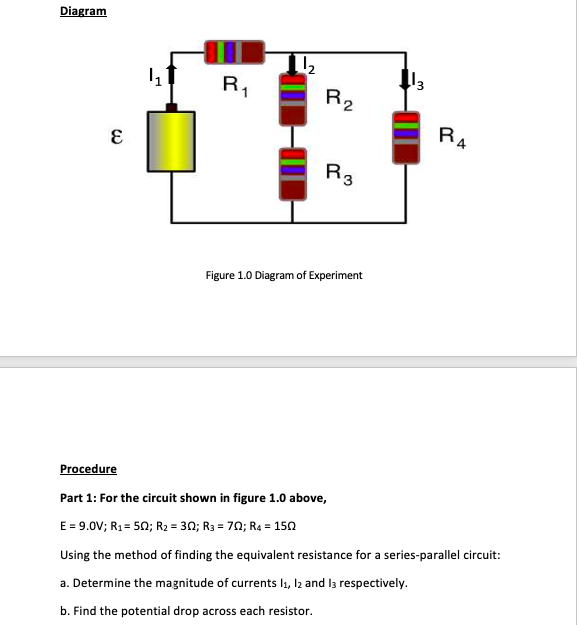Part 1: For the circuit shown in figure 1.0 above, E = 9.0V; R1 = 50; R2 = 30; R3 = 70; R4 = 150 Using the method of finding the equivalent resistance for a series-parallel circuit: a. Determine the magnitude of currents l1, l2 and la respectively. b. Find the potential drop across each resistor
Part 1: For the circuit shown in figure 1.0 above, E = 9.0V; R1 = 50; R2 = 30; R3 = 70; R4 = 150 Using the method of finding the equivalent resistance for a series-parallel circuit: a. Determine the magnitude of currents l1, l2 and la respectively. b. Find the potential drop across each resistor
Glencoe Physics: Principles and Problems, Student Edition
1st Edition
ISBN:9780078807213
Author:Paul W. Zitzewitz
Publisher:Paul W. Zitzewitz
Chapter24: Magnetic Fields
Section: Chapter Questions
Problem 75A
Related questions
Question

Transcribed Image Text:Diagram
R1
R4
R3
Figure 1.0 Diagram of Experiment
Procedure
Part 1: For the circuit shown in figure 1.0 above,
E = 9.0V; R1 = 50; R2 = 30; R3 = 70; R4 = 150
Using the method of finding the equivalent resistance for a series-parallel circuit:
a. Determine the magnitude of currents l1, l2 and la respectively.
b. Find the potential drop across each resistor.
Expert Solution
This question has been solved!
Explore an expertly crafted, step-by-step solution for a thorough understanding of key concepts.
This is a popular solution!
Trending now
This is a popular solution!
Step by step
Solved in 2 steps

Knowledge Booster
Learn more about
Need a deep-dive on the concept behind this application? Look no further. Learn more about this topic, physics and related others by exploring similar questions and additional content below.Recommended textbooks for you

Glencoe Physics: Principles and Problems, Student…
Physics
ISBN:
9780078807213
Author:
Paul W. Zitzewitz
Publisher:
Glencoe/McGraw-Hill

Glencoe Physics: Principles and Problems, Student…
Physics
ISBN:
9780078807213
Author:
Paul W. Zitzewitz
Publisher:
Glencoe/McGraw-Hill